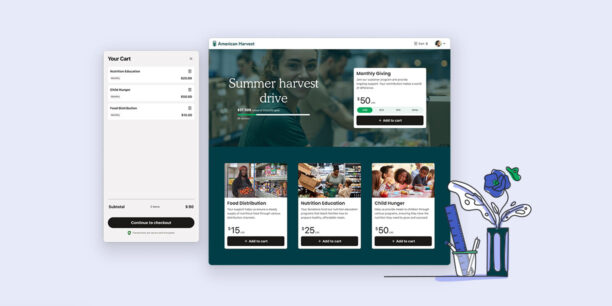5 Major Gift Fundraising Tactics to Apply Online

Request a Demo
Learn how top nonprofits use Classy to power their fundraising.
This blog was written by Sean Kosofsky, owner of Mind the Gap Consulting. Sean is a coach, consultant, trainer, and strategic advisor for nonprofits nationwide. For over 30 years, he has helped causes, campaigns, and candidates raise millions to transform nonprofit fundraising.
There are certain evergreen fundamentals every nonprofit fundraising team should know to effectively engage and retain major donations, regardless of your mission or fundraising strategy. Below, we address some of the most critical tried-and-true tactics for major gift fundraising to help amplify your impact.
1. Leverage Peer-to-Peer Fundraising to Get Major Donors in Your Orbit
People are more likely to take action if asked to do so by people they know. That means neighbors talking to neighbors and family talking over dinner can greatly influence donor cultivation. It also means human connection and strong relationships are far more powerful than any brand marketing available to consumers.
Your fundraising platform plays a powerful role in establishing and nurturing meaningful donor relationships online. Without the right tech stack, your team’s efforts to craft and share a story that resonates with major gift prospects will likely fall flat.
Peer-to-peer fundraising allows you to pull many of these elements together by sharing your stories at scale, deepening and investing in trusted relationships using technology. Knowing that people are more likely to support an organization if invited by a trusted person, peer-to-peer fundraising can be a great way to get major gift donors into your ecosystem.
In fact, Classy’s Why America Gives report found that 67% of donors are most likely to find new causes through word of mouth from friends and family. And since personal relationships are at the root of major gift fundraising, organic appeals from those closest to them are more likely to be well received by givers.
This becomes easier to track and scale with a reliable peer-to-peer fundraising platform. For example, some donors may first enter your organization’s sphere as small donors during a campaign, but if you continue to learn about and integrate these donors into your stewardship plan, they may become invested enough in your cause to upgrade to major donors.
2. Make the Giving Experience Personal
Keeping notes and records in your donor database about returning supporters’ areas of interest is crucial for major donor prospect research. This lets you connect with loyal donors personally, opening the door for authentic relationship-building and a potential on-ramp to becoming a major donor.
You can learn more about a donor’s interests by assessing their giving history, identifying their event attendance history, pinpointing their program designation selections, and more. You can also explore which social media channels they prefer.
Once you understand who your donors are, target your phone calls and emails to speak to them in a way tailored to their experiences. For example, send them content and updates on the initiatives you know they care about or may become interested in to prepare for future appeals. You can also use personalization in email openings and email subject lines to get their attention from the start.
3. Offer Regular Donor Touchpoints to Nurture Your Relationships and Gain Insights
A preexisting rapport is critical before going into an appeal for a major contribution, so engage your donor with a handful of quality conversations before any ask is made. Listen to their thoughts and opinions and ask follow-up questions. This demonstrates your interest in them and can help inform your organization’s decision-making.
In addition, ongoing conversations supported by regular touchpoints are critical to donor stewardship, so stay in touch with loyal donors virtually and in person throughout the year to remind them of their value in your organization. Establishing that unique connection is one of the most effective ways to inspire donors to increase their giving levels.
Equally important, most nonprofit organizations need to communicate more. In fact, Classy’s Recurring Donor SentimentReport found that 38% of donors would love to hear from the organizations they support more often.
Set a frequency of at least one email every other week and one social media post per week if possible. In addition to hitting the right amount of communication, you must be thoughtful, strategic, and creative to get noticed in peoples’ cluttered inboxes. This means segmenting particular messages to smaller audiences based on interest and using data to learn who engages with your communications.
Then, to deepen your archive of individual donor insights, consider sending surveys or asking questions in your communications. Each time someone opens, clicks, or replies, take note of it to better understand who engages with you most regularly. They can be cultivated to monthly or even larger donors if nurtured effectively.
4. Be Aspirational in Your Ask
It can confuse or even insult donors if you ask for a donation amount too far above or below their budget. It proves you don’t know much about them and risks steering them away. Finding that sweet spot is part art, part science, and always backed up with historical donation data points.
When asking for money, regardless of the amount, remind each donor that their gift is part of a larger goal. Explain how each donation fuels your annual fund or maybe helps you achieve your fundraising goal for a targeted capital campaign. People like to feel part of something bigger. It offers a sense of community and that collective action has an impact.
I’m a huge fan of asking donors for a stretch gift, which, as it implies, goes beyond their typical gift size. This is a great strategy for larger donors who may have the means to increase their giving levels but haven’t upgraded yet. When done effectively, you may even be able to get a supporter over the threshold to become a loyal contributor to your major giving program, or at least consider a larger gift than last time.
Consider these two approaches:
- “We’re looking for $25K by the end of July. Steven, if you can help close that gap with a gift of $15K, [XYZ will happen], and we’ll honor you at our annual event and within our annual report. However, if that amount feels out of reach, whatever you can donate will significantly impact our mission. With your help, we can achieve our goal and distill donations to our beneficiaries quicker.”
- “Steven, we can remodel the community center if we can find ten more donors to contribute $15K. Understanding that this is an extremely generous gift, we’d love to help make it more manageable by spreading your donation over two years through a quarterly recurring gift.”
Additionally, create multiple donation forms per campaign and push them out to different donor segments. Then, challenge them to consider a bigger gift by offering amounts you know are a stretch but are still within each donor’s financial capacity. This way, you can be sure you seize every opportunity to increase donations and raise more money for your mission.
5. Be Direct and Specific
When we want someone to change their behavior or take action, it’s typically more effective to be specific with your directions or requests. Yet, often in fundraising, people avoid directness because they think it’s rude.
We need to be respectful of different approaches and preferences, but I believe we can raise more if people approach certain fundraising campaigns with a direct message. One approach could be something like, “We want to raise $10K this month and know this campaign can get us there. If everyone who visits this page gives $25, we will reach our goal by next week.”
Rather than appealing with a general donation ask, consider challenging donors to support your fundraising efforts with a specific gift amount. You’re more likely to get the gift you want if you tell your donors what you need and what the impact of their gifts will be. Impact blocks are a great way to put this gift strategy into practice.
Acquire and Nurture Major Gifts With Comprehensive Technology
Acquiring and retaining major donors is a result of offering the right experience to the right donor at the right time. This is only possible with the right technology from a comprehensive product suite that engages, nurtures, and grows your donor base.
Classy’s fundraising platform offers five campaign types, each providing a unique way to attract supporters through your story. This variety gives donors the freedom to choose how they want to engage, like a crowdfunding campaign or peer-to-peer fundraising. With Classy, you also have access to clean data and seamless integrations to inform your outreach strategies, aid in building relationships that last, and scale with you.
For more on how Classy compares to other fundraising platforms, check out our blog Classy vs. Classy Alternatives: Which Fundraising Platform Best Suits You?
Bonus Tip:
In addition to peer-to-peer fundraising, Facebook fundraisers can play an impactful role in your organization’s donor acquisition and major gifts program strategy. That’s why Classy’s integration with Facebook gives fundraisers the ability to expand their reach and multiply their impact by seamlessly integrating their Classy fundraising pages with Facebook.
While most of these gifts will be small or midsize donations, it’s an effective tactic to bring potential major donors into your atmosphere and fuel your fundraising goals. For tips on how to make the most of your Facebook fundraisers, explore my free Facebook fundraising guide.
Copy Editor: Ayanna Julien

Get Your Donor Acquisition Checklist
Subscribe to the Classy Blog
Get the latest fundraising tips, trends, and ideas in your inbox.
Thank you for subscribing
You signed up for emails from Classy
Request a Demo
Learn how top nonprofits use Classy to power their fundraising.
 Explore Classy.org
Explore Classy.org 

